Abstract
T cells from BALB/c mice infested 9 days before with Ixodes ricinus nymphs had a suppressed response to in vitro concanavalin A (Con A) stimulation compared to cells from uninfested mice. When laminin (the main component of the extracellular matrix) was used as a coating agent, the Con A response of naive mice was characterized by a decrease in cell proliferation, whereas there was no significant effect on the mitogen response of cells from infested mice. In contrast, an increased response to lipopolysaccharide (LPS) was observed when assaying lymph node cells of infested mice, probably reflecting an increase in B-lymphocyte number or activity. LPS cell stimulation was not modified by laminin. Supernatants of lymph node cells, taken 9 days after the first infestation of mice, stimulated with Con A in vitro, contained interleukin-10 (IL-10) but no significant levels of IL-5 as tested by enzyme-linked immunosorbent assay. At this stage of the infestation all T cells reactive with tick antigens generated in lymph nodes that drain the tick fixation site, were CD4+ cells, as determined by CD4+ depletion. With cells taken 9 days after the third infestation an increase of IL-5 and IL-10 was observed. The IL-10 levels were higher than the IL-5. According to these observations, we conclude that the reduction of T-cell proliferation in response to Con A observed in lymph node cells from infested mice, may be due to the combined effect of laminin interaction with T lymphocytes during migration and IL-10 production by these lymphocytes.
Full text
PDF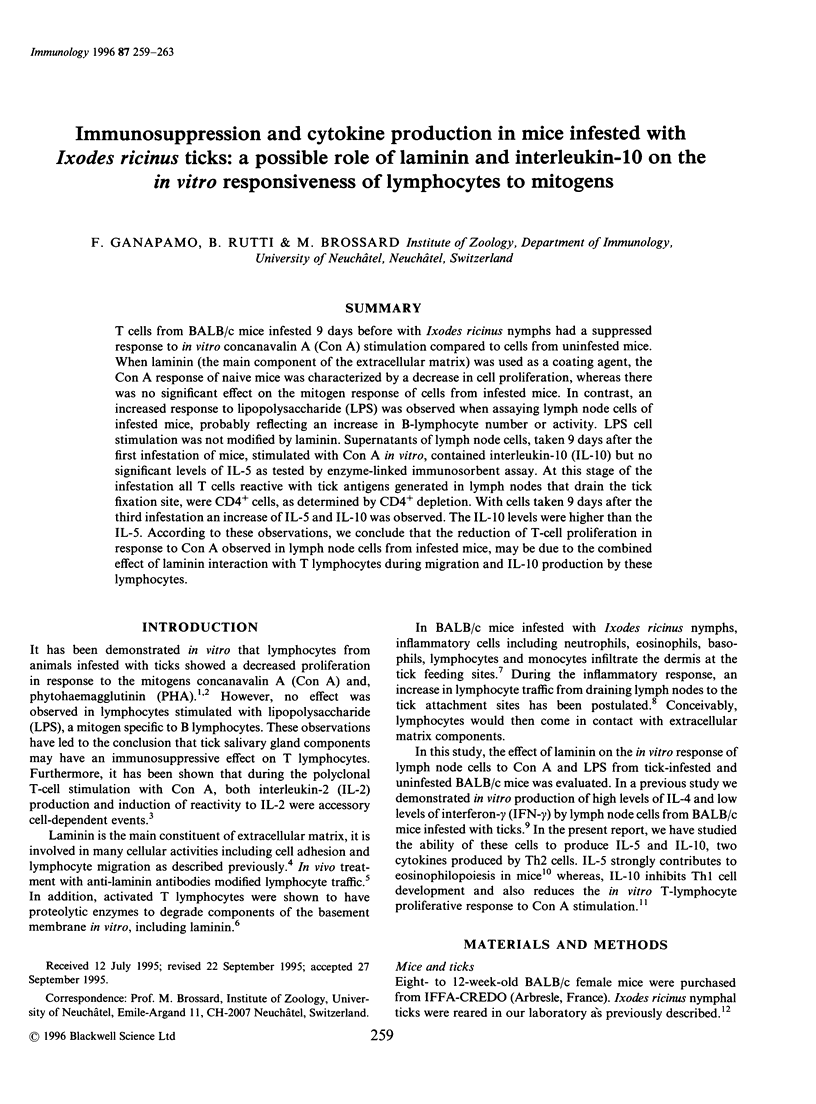
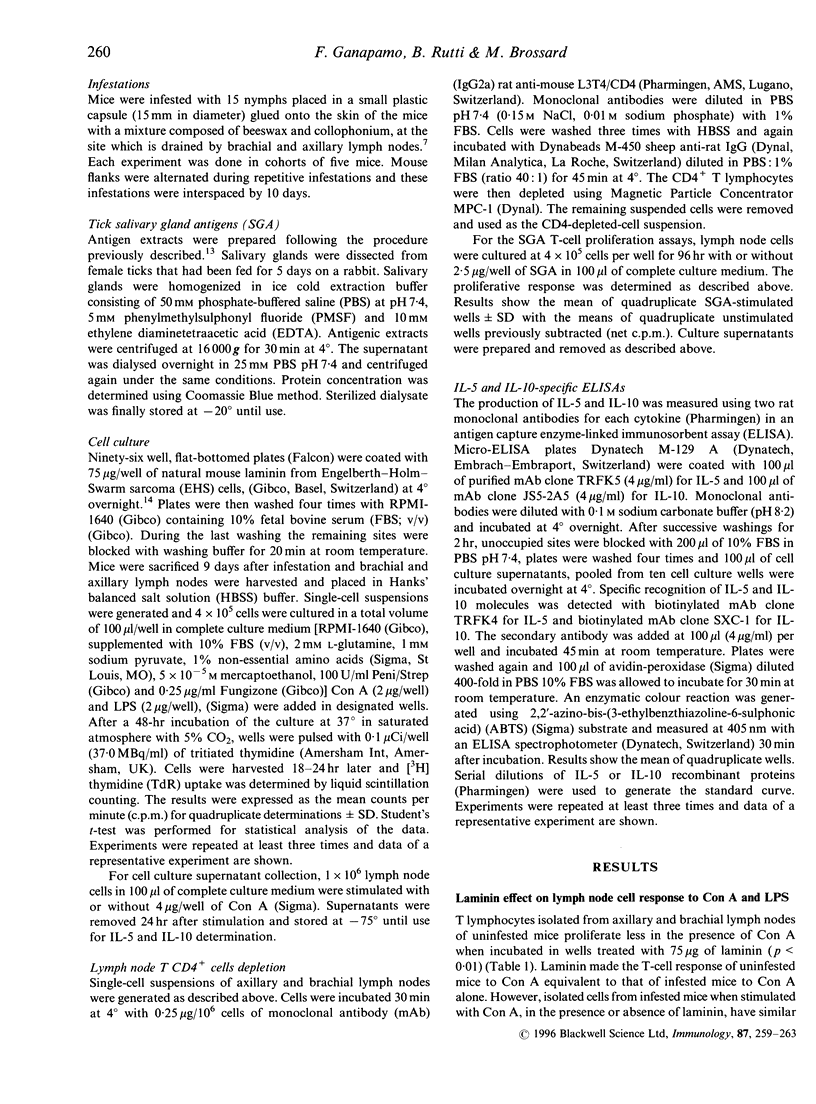
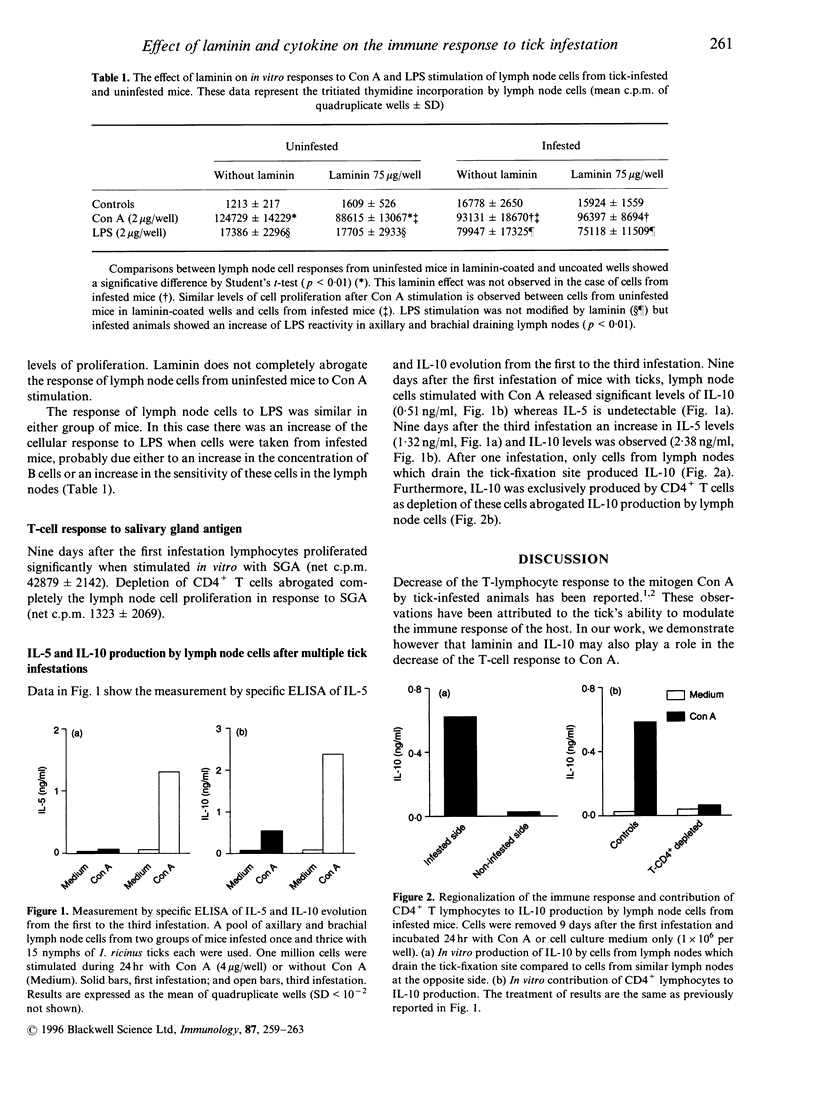
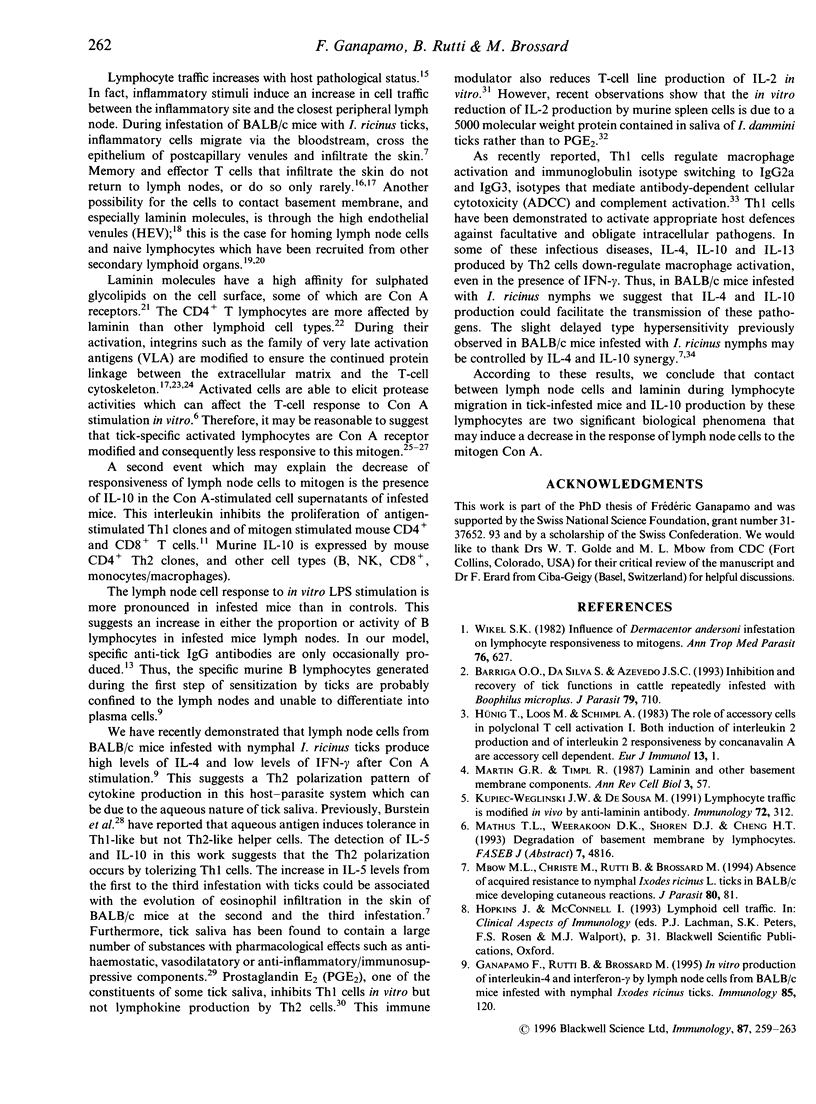
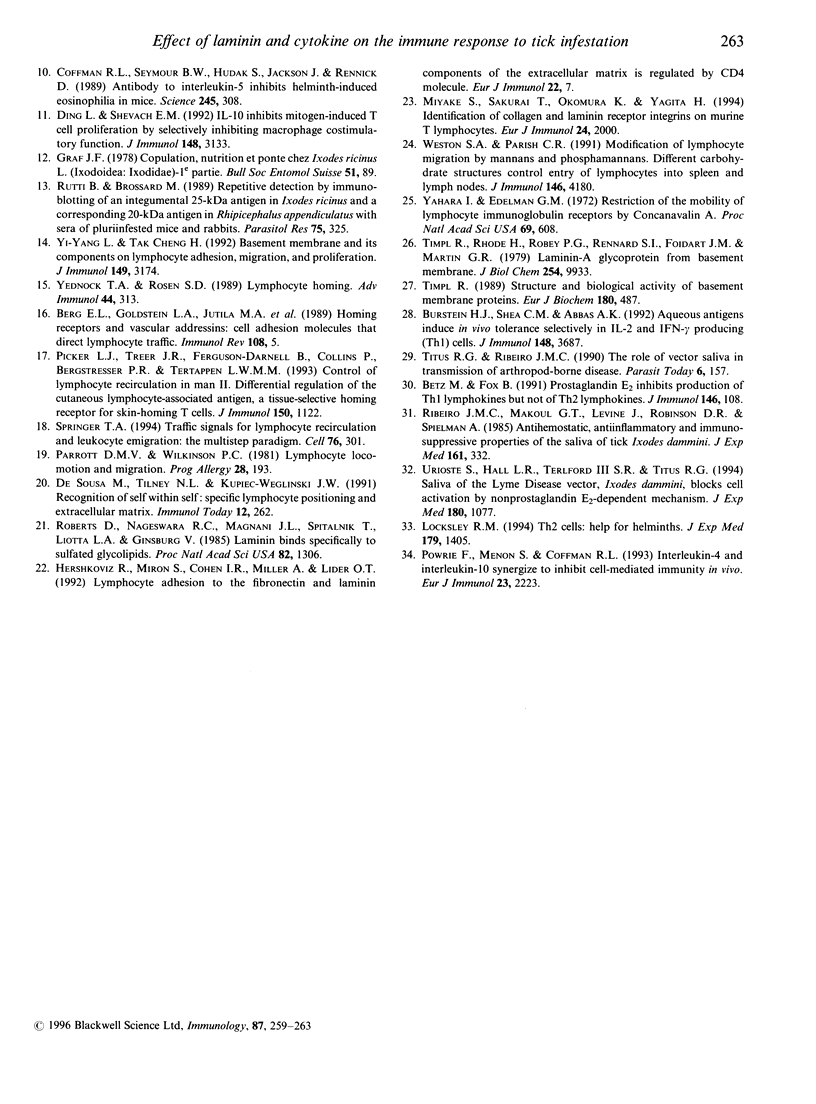
Selected References
These references are in PubMed. This may not be the complete list of references from this article.
- Barriga O. O., da Silva S. S., Azevedo J. S. Inhibition and recovery of tick functions in cattle repeatedly infested with Boophilus microplus. J Parasitol. 1993 Oct;79(5):710–715. [PubMed] [Google Scholar]
- Berg E. L., Goldstein L. A., Jutila M. A., Nakache M., Picker L. J., Streeter P. R., Wu N. W., Zhou D., Butcher E. C. Homing receptors and vascular addressins: cell adhesion molecules that direct lymphocyte traffic. Immunol Rev. 1989 Apr;108:5–18. doi: 10.1111/j.1600-065x.1989.tb00010.x. [DOI] [PubMed] [Google Scholar]
- Betz M., Fox B. S. Prostaglandin E2 inhibits production of Th1 lymphokines but not of Th2 lymphokines. J Immunol. 1991 Jan 1;146(1):108–113. [PubMed] [Google Scholar]
- Burstein H. J., Shea C. M., Abbas A. K. Aqueous antigens induce in vivo tolerance selectively in IL-2- and IFN-gamma-producing (Th1) cells. J Immunol. 1992 Jun 15;148(12):3687–3691. [PubMed] [Google Scholar]
- Coffman R. L., Seymour B. W., Hudak S., Jackson J., Rennick D. Antibody to interleukin-5 inhibits helminth-induced eosinophilia in mice. Science. 1989 Jul 21;245(4915):308–310. doi: 10.1126/science.2787531. [DOI] [PubMed] [Google Scholar]
- Ding L., Shevach E. M. IL-10 inhibits mitogen-induced T cell proliferation by selectively inhibiting macrophage costimulatory function. J Immunol. 1992 May 15;148(10):3133–3139. [PubMed] [Google Scholar]
- Ganapamo F., Rutti B., Brossard M. In vitro production of interleukin-4 and interferon-gamma by lymph node cells from BALB/c mice infested with nymphal Ixodes ricinus ticks. Immunology. 1995 May;85(1):120–124. [PMC free article] [PubMed] [Google Scholar]
- Hershkoviz R., Miron S., Cohen I. R., Miller A., Lider O. T lymphocyte adhesion to the fibronectin and laminin components of the extracellular matrix is regulated by the CD4 molecule. Eur J Immunol. 1992 Jan;22(1):7–13. doi: 10.1002/eji.1830220103. [DOI] [PubMed] [Google Scholar]
- Kupiec-Weglinski J. W., De Sousa M. Lymphocyte traffic is modified in vivo by anti-laminin antibody. Immunology. 1991 Feb;72(2):312–313. [PMC free article] [PubMed] [Google Scholar]
- Locksley R. M. Th2 cells: help for helminths. J Exp Med. 1994 May 1;179(5):1405–1407. doi: 10.1084/jem.179.5.1405. [DOI] [PMC free article] [PubMed] [Google Scholar]
- Martin G. R., Timpl R. Laminin and other basement membrane components. Annu Rev Cell Biol. 1987;3:57–85. doi: 10.1146/annurev.cb.03.110187.000421. [DOI] [PubMed] [Google Scholar]
- Miyake S., Sakurai T., Okumura K., Yagita H. Identification of collagen and laminin receptor integrins on murine T lymphocytes. Eur J Immunol. 1994 Sep;24(9):2000–2005. doi: 10.1002/eji.1830240910. [DOI] [PubMed] [Google Scholar]
- Parrott D. M., Wilkinson P. C. Lymphocyte locomotion and migration. Prog Allergy. 1981;28:193–284. [PubMed] [Google Scholar]
- Picker L. J., Treer J. R., Ferguson-Darnell B., Collins P. A., Bergstresser P. R., Terstappen L. W. Control of lymphocyte recirculation in man. II. Differential regulation of the cutaneous lymphocyte-associated antigen, a tissue-selective homing receptor for skin-homing T cells. J Immunol. 1993 Feb 1;150(3):1122–1136. [PubMed] [Google Scholar]
- Powrie F., Menon S., Coffman R. L. Interleukin-4 and interleukin-10 synergize to inhibit cell-mediated immunity in vivo. Eur J Immunol. 1993 Sep;23(9):2223–2229. doi: 10.1002/eji.1830230926. [DOI] [PubMed] [Google Scholar]
- Ribeiro J. M., Makoul G. T., Levine J., Robinson D. R., Spielman A. Antihemostatic, antiinflammatory, and immunosuppressive properties of the saliva of a tick, Ixodes dammini. J Exp Med. 1985 Feb 1;161(2):332–344. doi: 10.1084/jem.161.2.332. [DOI] [PMC free article] [PubMed] [Google Scholar]
- Roberts D. D., Rao C. N., Magnani J. L., Spitalnik S. L., Liotta L. A., Ginsburg V. Laminin binds specifically to sulfated glycolipids. Proc Natl Acad Sci U S A. 1985 Mar;82(5):1306–1310. doi: 10.1073/pnas.82.5.1306. [DOI] [PMC free article] [PubMed] [Google Scholar]
- Rutti B., Brossard M. Repetitive detection by immunoblotting of an integumental 25-kDa antigen in Ixodes ricinus and a corresponding 20-kDa antigen in Rhipicephalus appendiculatus with sera of pluriinfested mice and rabbits. Parasitol Res. 1989;75(4):325–329. doi: 10.1007/BF00931818. [DOI] [PubMed] [Google Scholar]
- Springer T. A. Traffic signals for lymphocyte recirculation and leukocyte emigration: the multistep paradigm. Cell. 1994 Jan 28;76(2):301–314. doi: 10.1016/0092-8674(94)90337-9. [DOI] [PubMed] [Google Scholar]
- Timpl R., Rohde H., Robey P. G., Rennard S. I., Foidart J. M., Martin G. R. Laminin--a glycoprotein from basement membranes. J Biol Chem. 1979 Oct 10;254(19):9933–9937. [PubMed] [Google Scholar]
- Timpl R. Structure and biological activity of basement membrane proteins. Eur J Biochem. 1989 Apr 1;180(3):487–502. doi: 10.1111/j.1432-1033.1989.tb14673.x. [DOI] [PubMed] [Google Scholar]
- Titus R. G., Ribeiro J. M. The role of vector saliva in transmission of arthropod-borne disease. Parasitol Today. 1990 May;6(5):157–160. doi: 10.1016/0169-4758(90)90338-5. [DOI] [PubMed] [Google Scholar]
- Urioste S., Hall L. R., Telford S. R., 3rd, Titus R. G. Saliva of the Lyme disease vector, Ixodes dammini, blocks cell activation by a nonprostaglandin E2-dependent mechanism. J Exp Med. 1994 Sep 1;180(3):1077–1085. doi: 10.1084/jem.180.3.1077. [DOI] [PMC free article] [PubMed] [Google Scholar]
- Weston S. A., Parish C. R. Modification of lymphocyte migration by mannans and phosphomannans. Different carbohydrate structures control entry of lymphocytes into spleen and lymph nodes. J Immunol. 1991 Jun 15;146(12):4180–4186. [PubMed] [Google Scholar]
- Wikel S. K. Influence of Dermacentor andersoni infestation on lymphocyte responsiveness to mitogens. Ann Trop Med Parasitol. 1982 Dec;76(6):627–632. doi: 10.1080/00034983.1982.11687593. [DOI] [PubMed] [Google Scholar]
- Yahara I., Edelman G. M. Restriction of the mobility of lymphocyte immunoglobulin receptors by concanavalin A. Proc Natl Acad Sci U S A. 1972 Mar;69(3):608–612. doi: 10.1073/pnas.69.3.608. [DOI] [PMC free article] [PubMed] [Google Scholar]
- Yednock T. A., Rosen S. D. Lymphocyte homing. Adv Immunol. 1989;44:313–378. doi: 10.1016/s0065-2776(08)60645-8. [DOI] [PubMed] [Google Scholar]
- de Sousa M., Tilney N. L., Kupiec-Weglinski J. W. Recognition of self within self: specific lymphocyte positioning and the extracellular matrix. Immunol Today. 1991 Aug;12(8):262–266. doi: 10.1016/0167-5699(91)90123-B. [DOI] [PubMed] [Google Scholar]


